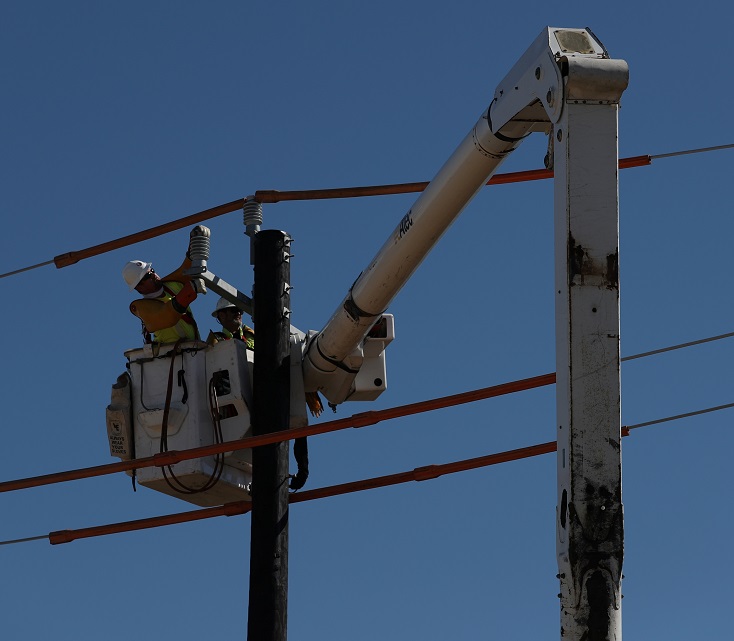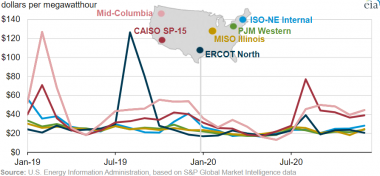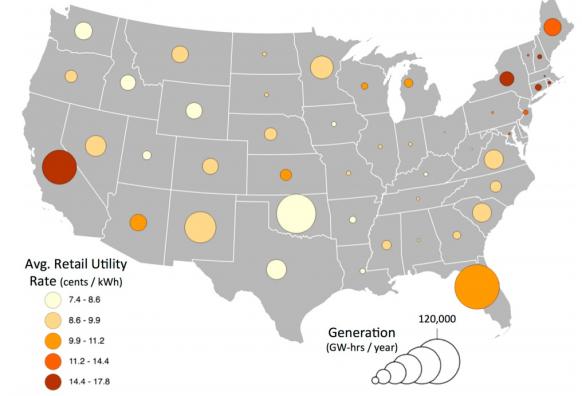Texas storm pricing sends shockwaves through power sector; Xcel to build 2.9 GW of solar
Our pick of the latest solar news you need to know.

Related Articles
Big freeze pushes Texas' largest power cooperative into bankruptcy
Texas' largest power cooperative Brazos Electric filed for bankruptcy March 1 following huge charges incurred in last month's winter storm.
Over 4 million Texans were left without power and dozens of people died after a rare cold snap fell upon the South.
By February 15, some 34 GW of power generation was offline in Texas - around 40% of expected capacity - as extreme low temperatures and ice cut wind, gas, coal and nuclear generation. Texas is a deregulated power market and is more used to supply shortages in the summer, when hot weather hikes air-conditioning demand. Texas is the fastest-growing solar market and will reach 10 GW of capacity by the end of 2021.
Amid freezing temperatures, coordinated blackouts were implemented across the Electric Reliability Council of Texas (ERCOT) power grid and customers were urged to limit power usage to prevent system-wide outages. ERCOT raised power prices to $9,000/MWh to encourage power generators to stay online. After the event, ERCOT was criticised for maintaining prices at high levels for too long a period, leading to $16 billion of excess market costs. The Texas Public Utility Commission ruled ERCOT did not have to compensate market participants for the error.
US monthly average wholesale power prices
(Click image to enlarge)
After the storm passed, ERCOT directors and the chair of the Texas Public Utility Commission resigned, Texas Governor Greg Abbott pledged to overhaul the grid operator, and generators and suppliers were left reeling from the financial impact. The grid operator then fired its CEO Bill Magness after the fallout of the pricing error became clearer.
Brazos, a generation and transmission cooperative, filed for Chapter 11 bankruptcy relief after receiving a $2.1 billion bill for power purchased during the storm, the group announced March 1.
"As a cooperative whose costs are passed through to its members, and which are ultimately borne by Texas retail consumers served by its Member cooperatives, Brazos Electric determined that it cannot and will not foist this catastrophic financial event on its members and those consumers," it said.
Brazos would continue to deliver "affordable and reliable electric service" to its member cooperatives, it said.
Ratings agency Moody’s downgraded ERCOT by one notch to A1 from Aa3 on March 5 and revised the grid operator’s credit outlook to “negative.”
Fitch warned the financial fallout from the storm could impact credit ratings across the Texas power market.
"Power generators with firm supply obligations that were unable to produce power may experience significant losses. Retail Electric Providers (REPs) forced to purchase power at elevated wholesale prices to meet surge in customer demand face significant losses, in addition to potential bad debts and delayed payments from end customers facing astronomical electricity bills," Fitch said.
Vistra Corp, an integrated power group, said the winter storm had a negative impact of $900 million to $1.3 billion on the company, according to preliminary estimates. During the storm, Vistra increased its share of power generation in Texas from 18% to between 25 and 30%, but it also had to buy power in the ERCOT market at or near the maximum price cap levels in order to meet supply obligations, it said.
"The final amount of the estimated loss is subject to a variety of factors including, but not limited to, outstanding pricing, load, and settlement data from ERCOT, potential state corrective action, or the outcome of potential litigation arising from this event," it said.
Algonquin Power & Utilities Corp warned of an expected impact on adjusted core earnings of $45 million to $55 million after the cold weather stopped production at its wind facilities.
Innergex estimated a negative impact of around $80 million after its wind farms were halted or disrupted by the storm.
DeAnn Walker, chairwoman of the Texas Public Utility Commission, resigned March 1 after testifying to the Senate and House on February 25.
In her resignation letter, Walker said the failure of the grid was "not caused by any one individual or group."
Power generators, transmission and distribution utilities, electric cooperatives, municipality-owned utilities, ERCOT, the Railroad commission and government representatives all failed to take the necessary steps over the last 10 years that could have averted the issues, Walker said.
Colorado utility Xcel to build 2.9 GW of solar
Colorado utility Xcel Energy plans to install 1.6 GW of large-scale solar power capacity and 1.3 GW of distributed solar by 2030 in a new plan to double renewable energy capacity by 2030.
Xcel plans to add 5.6 GW of renewable energy capacity in Colorado, including 400 MW of energy storage, in a bid to reduce carbon emissions by 85% by 2030, the company said February 24.
Xcel will build 1.3 GW of firm dispatchable power generation, including natural gas capacity, to fulfil its carbon reduction objectives, the utility said. Coal-fired generation will be significantly reduced by 2030 and all coal units will be taken off-line by 2040, it said.
President Joe Biden wants power generators to decarbonise faster and achieve a zero-carbon US power generation sector by 2035.
Under its current plan, Xcel aims to have a zero-carbon power generation portfolio by 2050.
Largest US floating solar plant completed in California
Developers White Pine Renewables and Noria Energy have completed the largest floating solar farm in the US on a wastewater treatment plant in California.
Located in the Sonoma wine region, the 4.8 MW facility will deliver power to the city of Healdsburg under a 25-year power purchase agreement (PPA), the project partners said.
Interest in floating solar plants is growing as solar technology costs fall and land becomes more scarce.
Floating solar concepts present some structural challenges, but can also improve panel efficiency and water preservation. The Healdsburg facility will reduce water evaporation and algae growth in the water treatment plant, benefiting the surrounding vineyards, the developers said.
Global installed floating solar capacity hiked from 10 MW in 2015, to 3 GW at the end of 2019, with early activity mainly concentrated in Asia. Growth is spreading and annual installations could rise to over 3 GW by 2022, according to forecasts from Wood Mackenzie.
Floating solar on human-made water bodies could eventually supply 10% of US power generation, the US National Renewable Energy Laboratory (NREL) said in a 2019 report. The study excluded water bodies used for recreation, fishing, navigation and wildlife conservation.
US potential floating solar capacity, utility rates
(Click image to enlarge)
Source: NREL report 'Floating Photovoltaic Systems: Assessing the Technical Potential' (2019)
Iberdrola unveils 755 MW of new solar projects in central Spain
Iberdrola is to build two more solar plants of total capacity 755 MW in the Extremadura region in central Spain and will double its renewable energy capacity in the region to 5.5 GW by 2023, the company announced March 3.
The 380 MW Tagus plant will be located in the Alcantara municipality, while the 375 MW Cedillo plant will be located between Alcantara and Herrera de Alcantara. The projects represent a total investment of 420 million euros ($498.9 million).
Elsewhere in Extremadura, Iberdrola recently brought online its 500 MW Nunez de Balboa plant - the largest solar facility in Europe - and is developing the 590 MW Francisco Pizarro plant. The group's other projects include the 328 MW Ceclavin, 150 MW Aranuelo I, II and III, 150 MW Arenales and 100 MW Cedillo plants.
Globally, Iberdrola plans to invest 150 billion euros by 2030 and triple its installed renewable energy capacity to 95 GW, the company said in annual results published February 24.
Last year, Iberdrola announced it would spend 75 billion euros by 2025, of which half on renewables, doubling its installed capacity to 60 GW. By 2025, Iberdrola aims to achieve 16 GW of installed solar capacity, 26 GW of onshore wind, 4 GW of offshore wind and 14 GW of hydro, the company said.
Iberdrola invested 9.2 billion euros in 2020, of which 91% was on renewables and power grids, the group said. Net profit rose 4.2% to 3.6 billion euros and underlying operating profit (EBITDA) climbed 8% to 10.7 billion euros, excluding the impact of COVID-19 and exchange rates.
Iberdrola's acquisition spree last year included the buyout of US utility PNM Resources through its US subsidiary Avangrid. The deal expands Avangrid's regulated asset base to 10 regulated companies across six states and makes it the third-largest renewable energy company in the US.
EDP Renewables to install 50 GW by 2030
EDP Renewables (EDPR) plans to install 4 GW of solar and wind capacity per year through 2025 and install 50 GW of renewables by 2030 in an accelerated growth plan.
EDPR is controlled by Portuguese utility EDP and has 20 GW of installed renewable energy capacity. EDP plans to spend 24 billion euros ($28.5 billion) in the next five years, of which 80% on renewables and 15% on grid infrastructure, and become carbon neutral by 2030, the utility said in a strategic update February 25.
Renewables currently make up 79% of EDP's global portfolio and will represent 100% by 2030, it said.
Annual investments will rise from 2.9 billion euros in 2019-2020 to 4.8 billion euros in 2021-2025, EDP said.
Some 40% of this will be invested in Europe, 40% in North America, 15% in Brazil and Latin America and 5% in the rest of the world, it said.
EDPR is considering raising between 1.5 and 2 billion euros from institutional investors, EDP said.
EDP currently owns 82.6% of EDPR and would maintain a stake of more than 70% in the company, it said.
Italy's Enel also recently hiked its renewable energy outlook, setting a global target of 120 GW of installed capacity by 2030.
Reuters Events


